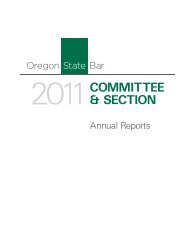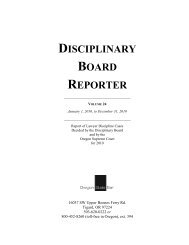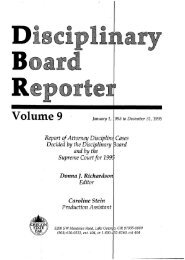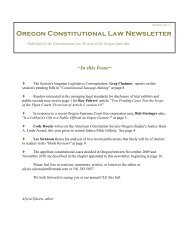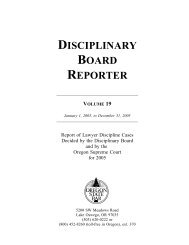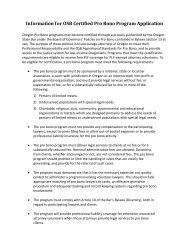February 22, 2013 - Oregon State Bar
February 22, 2013 - Oregon State Bar
February 22, 2013 - Oregon State Bar
Create successful ePaper yourself
Turn your PDF publications into a flip-book with our unique Google optimized e-Paper software.
Law Schools’ Applications Fall as Costs Rise and Jobs Are Cut - NYTim...<br />
http://www.nytimes.com/<strong>2013</strong>/01/31/education/law-schools-applications-...<br />
2 of 3 1/31/<strong>2013</strong> 8:28 AM<br />
In addition, legal forms are now available online and require training well below a lawyer’s to fill<br />
them out.<br />
In recent years there has also been publicity about the debt load and declining job prospects for<br />
law graduates, especially of schools that do not generally provide employees to elite firms in major<br />
cities. Last spring, the American <strong>Bar</strong> Association released a study showing that within nine months<br />
of graduation in 2011, only 55 percent of those who finished law school found full-time jobs that<br />
required passage of the bar exam.<br />
“Students are doing the math,” said Michelle J. Anderson, dean of the City University of New York<br />
School of Law. “Most law schools are too expensive, the debt coming out is too high and the<br />
prospect of attaining a six-figure-income job is limited.”<br />
Mr. Tamanaha of Washington University said the rise in tuition and debt was central to the<br />
decrease in applications. In 2001, he said, the average tuition for private law school was $23,000;<br />
in 2012 it was $40,500 (for public law schools the figures were $8,500 and $23,600). He said that<br />
90 percent of law students finance their education by taking on debt. And among private law<br />
school graduates, the average debt in 2001 was $70,000; in 2011 it was $125,000.<br />
“We have been sharply increasing tuition during a low-inflation period,” he said of law schools<br />
collectively, noting that a year at a New York City law school can run to more than $80,000<br />
including lodging and food. “And we have been maximizing our revenue. There is no other way to<br />
describe it. We will continue to need lawyers, but we need to bring the price down.”<br />
Some argue that the drop is an indictment of the legal training itself — a failure to keep up with the<br />
profession’s needs.<br />
“We have a significant mismatch between demand and supply,” said Gillian K. Hadfield, professor<br />
of law and economics at the University of Southern California. “It’s not a problem of producing too<br />
many lawyers. Actually, we have an exploding demand for both ordinary folk lawyers and big<br />
corporate ones.”<br />
She said that, given the structure of the legal profession, it was hard to make a living dealing with<br />
matters like mortgage and divorce, and that big corporations were dissatisfied with what they see<br />
as the overly academic training at elite law schools.<br />
The drop in law school applications is unlike what is happening in almost any other graduate or<br />
professional training, except perhaps to veterinarians. Medical school applications have been<br />
rising steadily for the past decade.<br />
Debra W. Stewart, president of the Council of Graduate Schools, said applicants to master of<br />
business degrees were steady — a 0.8 percent increase among Americans in 2011 after a decade of<br />
substantial growth. But growth in foreign student applications — 13 percent over the same period<br />
— made up the difference, something from which law schools cannot benefit, since foreigners have




